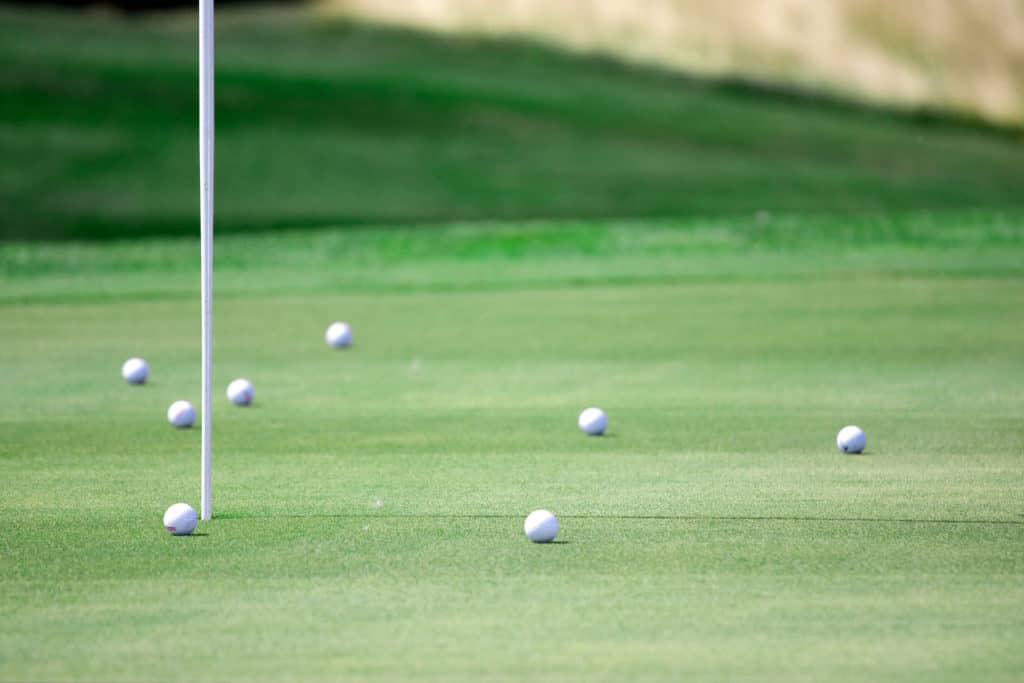We have all heard the term, “drive for show, putt for dough”
Has the following ever happened to you?
You make an amazing, awesome, power driver swing and the ball long and far.
You hit your next shot within 10 feet and you are thinking birdie!
You step up to the putt and miss the putt or even worse 3 putt!
You leave the green frustrated and it carries over to the next shot.
The reality is that we must be able to make the putts inside of 10 feet and hit quality lag putts out of 30 feet.
The technology and the number of options with putters has increased over the years and it is not uncommon to see the professional golfers of today experimenting with different putts, different grips and really anything that might give them a slight edge and some confidence for that weeks tournaments.
Most amateurs are not much different. They want something to give them confidence on the greens and to be able to make the putts when it matters the most.
For years I putted with a blade Scotty Cameron and had a ton of success. I eventually switched to a two ball mallet head style putter and have continued on. I have both options (learn more about swing method options here) to turn to when I need a different feel or are playing certain styles of greens.
The mallet putter is one option if you are struggling with your putter or you simply want a different option to turn to at certain points throughout a golf season!

How To Putt With A Mallet Putter
The recommendation is to take a more straight back and straight through putting stroke. Allowing the club to swing more like a pendulum in the putting stroke as a result of the majority of the weight sitting more towards the face will help provide a smooth, reliable stroke.
Tips For the Mallet Putter
- Straight back, straight through putting stroke
- Allow the club and gravity to work
- Utilize the visuals of the mallet putter
Tip #1: Straight Back and Straight Through
Due to the design of the putter head on a mallet, I always felt that there is less hit and more of smooth putting stroke. The golfer needs to remain patient with the mallet and allow the weight of the head to move back and through.
With a blade putter, there can be slightly more hit, which sets up better for a more rounded putting stroke where the face might slowly open and then slowly close as it comes through the ball.
Overall, the key is to find a stroke that works for you. One where the face consistently squares up the the start line and one that you can control the speed with.
When I am putting my best, I am able to allow the weight of the putter to help guide the stroke back and through the ball. There is very little hit or rush in the putting stroke. The ball gets a smooth roll and if I read the green correctly, my chances of making the putt are higher than with my blade putter!
Tip #2: Allow the club and gravity to work
One swing through when putting is to simply take the club far enough back to create the momentum in the club head to get through the hitting zone with enough energy to roll the ball far enough for the length of the putt.
The more you allow the technology and gravity to work together, the less manipulation of the club face will occur and you will increase your chances of making the putt.
If you get quick and jerky with your putt, chances are your face will not properly square up and you will miss putts, left and right, short and long. Stay patient over the putt and allow gravity to be your friend!
Tip #3: Utilize the visuals of a mallet putter
The greatest benefit of the mallet is the visuals that are often provided. There are creative ways manufactures have helped golfers out with visuals through shapes of club design, lines on the putter and even a 2 ball putter.
These visual designs are there to provide the golf with confidence and consistency in lining up the putter to start on the appropriate start line. Use these visuals to your advantage. Start the reading of each putt from behind the ball.
Next, make sure you line up the line on your putter to aim where you want the ball to start. Then approach the shot and utilize the visuals to get the club aiming in the direction you desire. Now is when the fun starts. Allow the weight of the club and gravity to take over and allow the arm and club unit to swing freely.
Follow your routine, which should include the visuals to make more putts!

Benefits of the Mallet Putter
- Quality sight lines through create design by the club experts.
- The location of the weight provides confidence to the golfer.
- The larger, thicker style putter provides an extra level of confidence.
- Mallets provide a great level of forgiveness.
- The higher level of MOI (moment of inertia) helps reduce the negative effects of off centered hits.
- Increase level of control and stability through the hitting zone.
How To Test A Mallet vs Blade Putter
I would recommend testing over several sessions. Here is a process you can follow. Repat this process 3 times for the most accurate comparison.
- Hit 10 putts from 10 feet with each style of putter.
- Record how many putts you make with each style.
- Next hit 10 putts from 30 feet.
- Record your distance left on each putt.
- Average your distance left and also how many putts here made.
- Compare your putts made from 10 feet, average distance from 30 feet and putts made from 30 feet over at least 3 practice sessions.
Prior to hit, make sure you have warmed up and have practice putting for at least 10 minutes.
You now have analytics to compare to your feel! Too many golfers remember that one putt they made with a certain putter. Make sure you look at the data to make decisions. Of course feel and confidence do factor in, but data should be considered!
Are Mallet Putters Better?
Yes, the weight distruction and level of control through the hitting zone help make mallet putters better for the majority of golfers. On field testing, most results give the advantage to the mallet putter.
Now of course there will be golfers that swear by their blades and they may putt better with their blade. However, for most amateurs and especially beginner golfers, I would highly recommend the mallet putter.
And for the better player?
I would recommend owning at least 2-3 putters of different styles. You will want to utilize different putters throughout the season to provide a different feel if you are struggling or if you are playing different speed greens.
I really enjoy my mallet on slower greens, but will turn to my blade putter on some really fast greens. Putting often comes down to preference, comfort level and overall confidence with the putter!
Find what works best for you, but make sure you have options throughout a season and over several season! The investment is worth it and a putter can last you for many years.
Other Putting Options
In addition to the blade and mallet head putters, golfers can also consider the counter balance putters, belly putters and the long putters. Even though the rules now prevent anchoring, these different style putters will provide different feels for the golfer.
At the end of the day, the golfer must determine and test out what is best for his or her game. Spending considerable time on the practice green will help the golfer make the best choice for their game.
Top 3 Recommend Putters
Mallet Putters: Final Thoughts
Golf is a difficult game, but it can be a ton of fun. One of the areas that makes it fun is the different options in club selections. Some of the best golfers I know have a bin of putters in their basement or garage as they are always seeking that next putter that will help them make more putts during a round of golf.
A golfers feel or vision can adjust over time and having the options to turn to might be helpful.
One simple tip to make more putts…
Why do golfers draw a line on their ball?

Take Action – What You Can Do Today to Get Better
What does this mean for you? I believe in the following recipe to get better:
1 – Improve your motion in the golf swing by identifying a golf instructor. Here are some options:
Here is a list of golf instructors that we have reviewed:
2 – Train to swing faster and improve your swing speed. Here are some options:
Looking to gain more Speed and Distance in your swing. Two Options:
3 – Understand course strategy and work to break through your next barrier. Here is a series on breaking through:
We have provided guides on how to break 100, 90, 80 and 70. Check out more below, if interested.
4 – Practice Frequently
Did you know that I build a golf simulator in my garage and have played over 500 rounds of golf on my SkyTrak system? It has been a game changer and one worth checking out. Here are some of my other posts on golf simulators frequently asked questions:
- Is a Golf Simulator Worth It?
- How to Build a Golf Simulator?
- What is the Best Golf Simulator?
- Golf Simulator Accessories?
- How to Build a Golf Simulator for under $7000
- Top 11 Reasons to Buy a SkyTrak
- How to Build a Golf Simulator for Under $1000
- Why Build A Golf Simulator?
- What Space is Needed?
- Can A Golf Simulator Improve My Game?
- How Much Does A Golf Simulator Cost?
- Don’t Forget to Check out our 15 best golf swings of all time.
